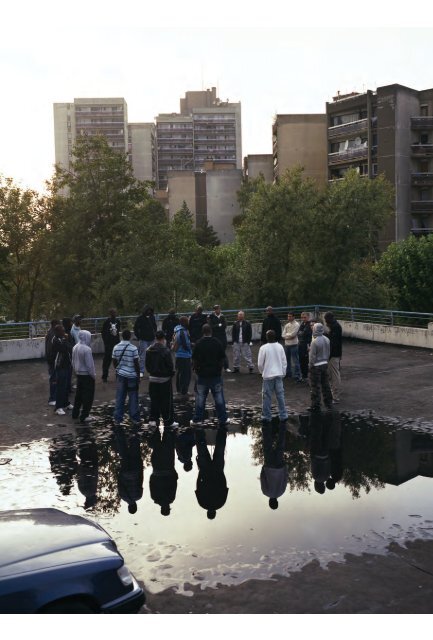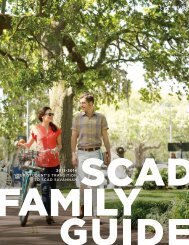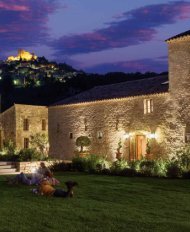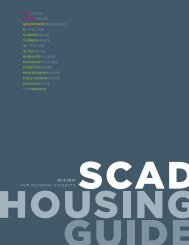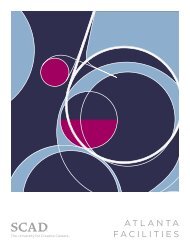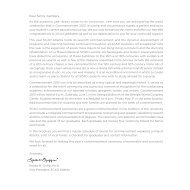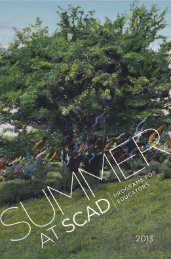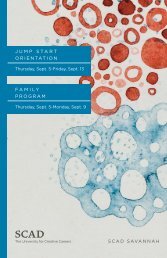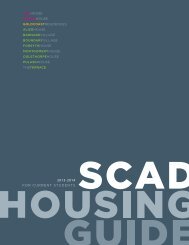View the exhibition catalog. - SCAD
View the exhibition catalog. - SCAD
View the exhibition catalog. - SCAD
You also want an ePaper? Increase the reach of your titles
YUMPU automatically turns print PDFs into web optimized ePapers that Google loves.
Mohamed Bourouissa<br />
LE MIROIR (THE MIRROR)<br />
Oct. 10 – Dec. 30, 2011<br />
Gallery See | <strong>SCAD</strong> Atlanta, 1600 Peachtree St. | Atlanta, Georgia<br />
Feb. 4 – May 6, 2012<br />
<strong>SCAD</strong> Museum of Art | 601 Turner Blvd. | Savannah, Georgia<br />
June 4 – August 24, 2012<br />
Moot Gallery | <strong>SCAD</strong> Hong Kong | 292 Tai Po Road, Sham Shui Po, Hong Kong<br />
Sept. 14 – Nov. 23, 2012<br />
La Galerie Pfriem | <strong>SCAD</strong> Lacoste, Rue Trophime | 84480 Lacoste, France
Le Miroir (The Mirror) was organized<br />
by <strong>SCAD</strong> with support from <strong>the</strong> French<br />
Cultural Services in Atlanta, Georgia, to<br />
complement <strong>the</strong> 2011 France Atlanta festival<br />
with cultural events focused on <strong>the</strong>mes of<br />
diversity and integration. The solo <strong>exhibition</strong><br />
features photographs by French artist Mohamed<br />
Bourouissa and is guest curated by lecturer,<br />
art critic and independent curator Simon<br />
Njami, with coordination support provided<br />
by <strong>SCAD</strong> Senior Curator Melissa Messina.<br />
Bourouissa’s oversized photographic tableaux<br />
vivants drop viewers into <strong>the</strong> heart of social<br />
tensions and struggles playing out in France<br />
as a result of <strong>the</strong> riots that took place in Paris<br />
in Fall 2005. These riots, which began in <strong>the</strong><br />
Parisian suburbs and <strong>the</strong>n spread to o<strong>the</strong>r areas<br />
of France, were incited primarily by racial<br />
injustices, frustration with high unemployment,<br />
and police harassment and brutality against<br />
African and Arab youths. The glances, nuanced<br />
gestures and flash points of Bourouissa’s images<br />
capture <strong>the</strong> energy, psychological dimensions<br />
and complexity of <strong>the</strong> underlying social rifts.<br />
His images also speak across time as Bourouissa<br />
draws compositional and conceptual inspiration<br />
from historic paintings such as Eugène<br />
Delacroix’s Liberty Leading <strong>the</strong> People, 1830.<br />
The vision and conceptual rigor of Bourouissa’s<br />
work fur<strong>the</strong>r <strong>the</strong> mission of <strong>the</strong> <strong>SCAD</strong><br />
<strong>exhibition</strong>s department that is committed<br />
to artistic diversity, to innovation and to<br />
originality, and aims to provide an educational<br />
forum for current trends in contemporary art.<br />
A very special thank you to Mohamed<br />
Bourouissa; Simon Njami; Mr. Pascal Le Deunff,<br />
Consul General of France in Atlanta; Carole<br />
Scipion, cultural attaché, Consulate General<br />
of France in Atlanta; Hea<strong>the</strong>r Kircher, French<br />
cultural services and press assistant, Consulate<br />
General of France in Atlanta; and galerie<br />
kamel mennour, Paris, for <strong>the</strong>ir numerous<br />
invaluable contributions to <strong>the</strong> <strong>exhibition</strong>,<br />
affiliated public programs and this <strong>catalog</strong>.<br />
laurie ann farrell<br />
Executive Director of Exhibitions, <strong>SCAD</strong><br />
left: Le Hall, 2007-08
A few years ago, <strong>the</strong> world watched in<br />
astonished disbelief mixed with a dash of<br />
ironic pleasure as <strong>the</strong> poor outlying suburbs of<br />
France’s large cities were set ablaze. This feeling<br />
of amazement that seized hold of those who<br />
viewed this violent fury stemmed from <strong>the</strong> fact<br />
that, still today, France is seen in <strong>the</strong> world<br />
to say that <strong>the</strong>y are alive and breathing. They<br />
lure in <strong>the</strong> television news cameras, which are<br />
wont to turn <strong>the</strong>ir lenses only toward an event,<br />
a spectacle that has become news. Mohamed<br />
Bourouissa is well aware of all that. He could<br />
have been one of those kids whose life ends<br />
on a scooter at <strong>the</strong> bottom of some street. He<br />
THE MIRROR by simon njami<br />
as <strong>the</strong> land of <strong>the</strong> Rights of Man and cultural<br />
diversity. To be honest, we were not <strong>the</strong> only<br />
ones to be moved by this kind of revolution,<br />
which still remains anchored in people’s<br />
memories. We were witnesses to an event, in<br />
<strong>the</strong> most etymological sense of <strong>the</strong> term–that<br />
is to say, to <strong>the</strong> rising up of <strong>the</strong> unexpected.<br />
France awoke to find itself forced to face its<br />
ghosts, to look squarely at <strong>the</strong> failures of its<br />
colonial past and its inability to really integrate<br />
into <strong>the</strong> French Republic all its subjects who<br />
were not considered to be “French like <strong>the</strong><br />
rest.” Suddenly, a generation left to its own<br />
devices, tired of being treated as nonexistent<br />
and systematically stigmatized, stood up and<br />
shouted out its despair and its anger. They are<br />
French–French like <strong>the</strong> rest. Though confined<br />
within <strong>the</strong> horizonless setting of high-rise<br />
housing projects far removed from city centers,<br />
<strong>the</strong>y are citizens of <strong>the</strong> French Republic. Their<br />
countries of origin, <strong>the</strong> lands from which<br />
<strong>the</strong>ir parents or <strong>the</strong>ir grandparents came, are<br />
quite often nothing but an old dream kept up<br />
within <strong>the</strong> family, a fantasy from which <strong>the</strong>y<br />
know <strong>the</strong>y are already excluded. So, <strong>the</strong>y burn<br />
in order to exist. They break things in order<br />
could have thrown some bricks through <strong>the</strong><br />
windows of <strong>the</strong> lavish stores in <strong>the</strong> French<br />
capital that seem to be <strong>the</strong>re just to taunt<br />
anyone who does not have <strong>the</strong> means to buy<br />
<strong>the</strong> luxury items inside.<br />
left: La Bascule, 2007-08<br />
right: Le miroir, 2007-08
But this has turned out not to be <strong>the</strong> case.<br />
Aware of <strong>the</strong> trap set beneath his feet, he has<br />
preferred to turn himself into a narrator and<br />
to enter into <strong>the</strong> necessarily fictitious world of<br />
artistic creativity in order to recount for us <strong>the</strong><br />
incoherent details of <strong>the</strong> society in which he<br />
lives. His gaze betrays no anger, just an acute<br />
sense of irony, a disabused look of amusement,<br />
a clear acknowledgment of <strong>the</strong> facts, done in<br />
a joking way. Before turning toward video, he<br />
chose photography as his primary medium,<br />
undoubtedly because of <strong>the</strong> documentary<br />
nature of <strong>the</strong> photographic print. Whe<strong>the</strong>r<br />
we like it or not, photography still makes us<br />
believe that what it reveals to us necessarily<br />
contains a slice of truth. With his constant<br />
mises en abyme (“placing into infinity”), <strong>the</strong>se<br />
self-reflexive embeddings he shows us in<br />
his photographs, Bourouissa has decided to<br />
play on this slice of truth and to deconstruct<br />
things to his heart’s content. He makes light of<br />
clichés and received ideas while making <strong>the</strong>m<br />
his own, adopting an intelligently distanced<br />
attitude that turns to ridicule French society’s<br />
most consistently recurring prejudices simply<br />
by staging <strong>the</strong>m. With dark humor, his<br />
tableaux are composed like a classical painting,<br />
underscoring all <strong>the</strong> contradictions inherent<br />
in that society. The models are chosen with<br />
care. Their clo<strong>the</strong>s perfectly cling to <strong>the</strong>ir<br />
roles, and <strong>the</strong>ir attitudes are meticulously<br />
choreographed by a stage director who is a<br />
stickler for details. And Bourouissa succeeds<br />
in creating <strong>the</strong> illusion he wishes to achieve.<br />
These young people who are playing <strong>the</strong>ir own<br />
roles have necessarily entered into what Jean-<br />
Paul Sartre had called <strong>the</strong> process of splitting.<br />
In becoming aware of <strong>the</strong> image <strong>the</strong>y are<br />
projecting within society, <strong>the</strong>y become o<strong>the</strong>r,<br />
abstractions, thinking beings who are making<br />
an ontological and political comment on <strong>the</strong><br />
gaze of those who want to trap <strong>the</strong>m within<br />
<strong>the</strong> image <strong>the</strong>y have agreed to take on. This<br />
is a fool’s game, a game of mirrors, in which<br />
those who thought <strong>the</strong>y were looking are in<br />
fact those who are under <strong>the</strong> watchful eye<br />
of o<strong>the</strong>rs. The mirror affords this necessary<br />
splitting. What is expressed here is <strong>the</strong><br />
impossibility of being “one,” <strong>the</strong> fact that this<br />
reflection of ourselves comes back deformed<br />
because it is but a reflection. This is <strong>the</strong><br />
reflection of a subject, no doubt, but still more<br />
it is a reflection of <strong>the</strong> world that surrounds<br />
this subject and of <strong>the</strong> setting that conditions<br />
<strong>the</strong> subject and dictates to him his humanity.<br />
Bourouissa’s work is eminently political, even<br />
though he would undoubtedly refrain from<br />
saying so. For, in being content to be a neutral<br />
observer and in being persuaded that <strong>the</strong>re is<br />
no need to add anything to <strong>the</strong> obvious facts<br />
he reveals, he becomes subversive. He starts<br />
to sing a sometimes forgotten hymn, <strong>the</strong> one<br />
Ernst Bloch had called <strong>the</strong> “key question:” <strong>the</strong><br />
self-contained question of “we.” For, in every<br />
“we,” <strong>the</strong>re is first of all an “I.” And how will<br />
we ever succeed in constructing a way of living<br />
toge<strong>the</strong>r that accepts difference as an item of<br />
wealth, as <strong>the</strong> sole guarantee of our aptitude<br />
for humanity? These are <strong>the</strong> pressing questions<br />
raised by Bourouissa’s photographs, <strong>the</strong><br />
violence of which appears so contained. And<br />
<strong>the</strong> French Republic–this symbol represented<br />
by blue, white and red–had better watch out,<br />
if it proves incapable of loving and protecting<br />
its children. All its children.<br />
Translated from French<br />
by David Ames Curtis.<br />
left: Le cercle imaginaire, 2008
EXHIBITION IMAGES
left: La rencontre, 2005<br />
right: L’impasse, 2007
Carré rouge, 2007-08
Le reflet, 2007-08
Le Périphérique, 2007
La fenêtre, 2007-08
INSTALLATION IMAGES
Mohamed Bourouissa<br />
LE MIROIR (THE MIRROR)<br />
ACKNOWLEDGEMENTS<br />
A very special thank you to <strong>the</strong> following<br />
Mohamed Bourouissa<br />
Simon Njami<br />
French Cultural Services, Atlanta<br />
galerie kamel mennour, Paris<br />
Yossi Milo Gallery, New York<br />
Additional <strong>SCAD</strong> Support<br />
Stacia Lorenze, Communications Manager<br />
E. Christina Spitz, Senior Writer/Editor<br />
Kate Firebaugh, Campus Liaison<br />
Design Press Printing<br />
Kevin Whitworth, Production Director<br />
Justin Malbrough, Art Director<br />
<strong>SCAD</strong> Exhibitions Department Staff<br />
Laurie Ann Farrell, Executive Director<br />
Ariel Krantz, Director of Events and Exhibitions,<br />
<strong>SCAD</strong> Atlanta<br />
Isolde Brielmaier, Ph.D., Chief Curator<br />
Melissa Messina, Senior Curator<br />
Erin Dziedzic, Curator<br />
Summer Orndorff, Registrar,<br />
<strong>SCAD</strong> Museum of Art<br />
Michael Runnels, Registrar<br />
Justin Ayars, Registrar/Gallery Assistant,<br />
<strong>SCAD</strong> Atlanta<br />
George Doles, Senior Exhibition Designer<br />
Allyson Burke, Art Preparator<br />
Ben Stanley, Art Preparator<br />
Alex Getz, Art Preparator<br />
Juliana Peloso, Art Preparator<br />
Emily King, Exhibitions Associate<br />
Rana Edgar, Exhibitions Coordinator<br />
IMAGE CREDITS<br />
All <strong>exhibition</strong>s images from <strong>the</strong> series Périphéries, C-print, courtesy of <strong>the</strong> artist and galerie kamel mennour, Paris.<br />
© Mohamed Bourouissa<br />
All installation images by John McKinnon, courtesy of <strong>SCAD</strong>, <strong>SCAD</strong> Museum of Art.
BIOGRAPHIES<br />
Bourouissa’s photographs were included in<br />
<strong>the</strong> New Museum of Contemporary Art’s<br />
<strong>exhibition</strong> Younger than Jesus in 2009.<br />
Bourouissa’s work was recently featured in<br />
a 2011 two-person <strong>exhibition</strong> Live Cinema/<br />
Peripheral Stages: Mohamed Bourouissa and<br />
Tobias Zielony at <strong>the</strong> Philadelphia Museum of<br />
Art. His work is included in <strong>the</strong> collections of<br />
<strong>the</strong> Fonds National d’Art Contemporain in<br />
Puteaux, France, and <strong>the</strong> Maison Européenne<br />
de la Photographie in Paris. Bourouissa was<br />
born in 1978 in Bilda, Algeria, and attended<br />
<strong>the</strong> Ecole Nationale Supérieure des Arts<br />
Décoratifs, Paris, and <strong>the</strong> Sorbonne, Paris.<br />
He lives and works in Paris.<br />
Simon Njami is a Paris-based independent<br />
curator, lecturer and art critic. Njami was <strong>the</strong><br />
co-founder and editor-in-chief of Revue Noire,<br />
a journal of contemporary African and extraoccidental<br />
art. He has served as artistic director<br />
of <strong>the</strong> Bamako photography biennale from<br />
2001-08, and he co-curated <strong>the</strong> first African<br />
pavilion at <strong>the</strong> 52 nd Venice Biennale in 2007.<br />
Njami has curated numerous <strong>exhibition</strong>s of<br />
African art and photography, including Africa<br />
Remix (2004/2007) and <strong>the</strong> first African Art<br />
Fair, held in Johannesburg in 2008. Currently<br />
Njami serves as adviser for <strong>the</strong> Sindika Dokolo<br />
Collection, and he is consultant in visual arts<br />
for <strong>the</strong> French Ministry of Foreign Affairs<br />
cultural branch.<br />
above: Raftermen Photography<br />
above: © Laurence Leblanc
<strong>SCAD</strong>: The University for Creative Careers<br />
The Savannah College of Art and Design is a private, nonprofit, accredited<br />
institution conferring bachelor’s and master’s degrees at distinctive locations and<br />
online to prepare talented students for professional careers. <strong>SCAD</strong> offers degrees<br />
in more than 40 majors.<br />
visit scad.edu.
scad.edu


